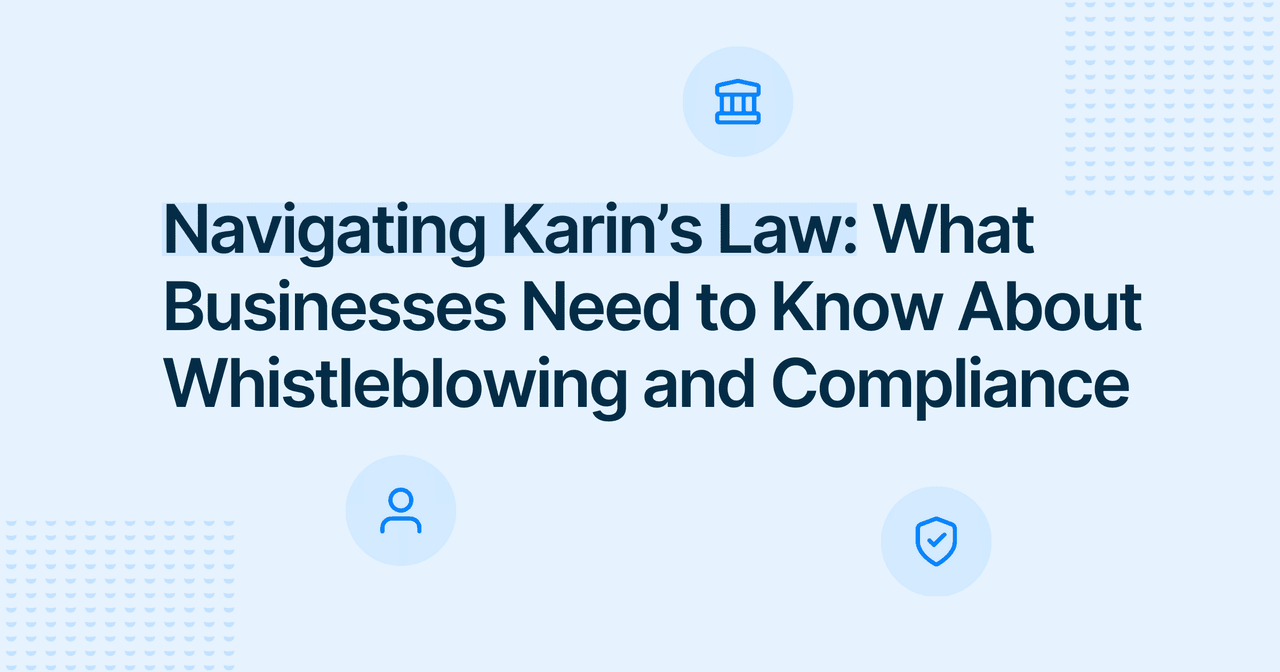



Discover the benefits of a transparent organization!
Try our free platform and strengthen the culture of openness in your team.
Whistleblowing

Yeva Bartkiv
Copywriter
Published
2025-05-27
Reading time
7 min


Table of contents
Subscribe to our newsletter
In today’s workplace, fostering a culture of openness, trust, and accountability is more crucial than ever. Employees want to feel safe when speaking up about issues that matter to them, whether it involves misconduct, harassment, safety violations, or unethical behavior.
One of the most effective ways organizations can encourage transparency is through anonymous reporting systems. These tools empower employees to report concerns without disclosing their identity, reducing the fear of retaliation and helping businesses proactively address problems before they escalate.

In this guide, you’ll learn everything you need to know about anonymous and confidential reporting systems. We'll cover what anonymous reporting entails, how it compares to whistleblowing, and the key benefits for companies and employees. and how to choose the right anonymous reporting platform for your organization.
You'll also learn how to choose the right anonymous reporting platform for your organization, how to build a strong speak-up culture, and align your processes with ethical and legal standards to create a safer, more compliant work environment.
Anonymous reporting is a practice that allows individuals to report workplace issues, misconduct, or feedback without revealing their identity. This can be achieved through digital platforms, telephone hotlines, or third-party reporting services.
What distinguishes anonymous reporting from other whistleblowing methods is the complete confidentiality it offers to the reporter. This is particularly valuable in scenarios involving sensitive workplace issues such as discrimination, harassment, fraud, or unsafe working conditions.
Organizations may offer both anonymous and confidential reporting options. Confidential reporting might allow for limited disclosure of the reporter's identity under secure conditions, while anonymous reporting systems are designed to keep the whistleblower’s identity entirely private.
Anonymous reporting systems can take many forms, including secure online portals, anonymous complaint hotlines, and whistleblower software tools. These systems enable companies to streamline their reporting process, enhance incident management, and improve risk management strategies.
Importantly, they help build trust and support a healthy workplace culture where employees feel safe to report concerns.
While these concepts are closely related, each has its distinct meaning and purpose. Anonymous reporting is the overarching process of submitting a concern without disclosing one’s identity. It can encompass a wide range of workplace issues, from safety concerns to interpersonal conflicts or violations of company policies.
Whistleblowing, by contrast, typically involves the exposure of serious misconduct, corruption, or illegal activity. Whistleblowers often report these issues internally through designated reporting channels or externally to regulatory authorities. Anonymous whistleblowing enables individuals to disclose such misconduct while protecting their personal safety and employment.
Feedback channels are often used for less critical concerns or general suggestions related to workplace improvements. These may include anonymous insights shared during employee surveys, suggestion boxes, or through employee engagement platforms.
While not all feedback rises to the level of a whistleblowing report, maintaining anonymous reporting capabilities for both serious and everyday issues is crucial to ensure comprehensive incident coverage.
Implementing an anonymous reporting system is a powerful way to demonstrate your company’s commitment to ethics, transparency, and accountability. When employees have access to anonymous reporting channels, they are more likely to come forward with concerns about unethical behavior or misconduct. This encourages early intervention, which can prevent issues from escalating into legal or reputational risks.
From a compliance standpoint, anonymous reporting is often required or strongly recommended in various industries, particularly those governed by regulatory frameworks. Organizations subject to whistleblower protection laws must provide safe and accessible avenues for employees to report misconduct without fear of reprisal.
Moreover, an effective anonymous reporting system helps organizations build a culture of trust. Employees who know their voices will be heard and protected are more engaged, satisfied, and committed to maintaining an ethical workplace.
Anonymous reporting platforms also facilitate better communication between employees and management by allowing for secure, two-way interaction that respects the reporter’s identity.
There are numerous benefits to adopting an anonymous reporting system in your organization, ranging from legal compliance to employee well-being. Understanding these advantages can help stakeholders make informed decisions about implementing the right systems for their use case.
For employees, anonymous reporting tools provide a safe outlet to report workplace issues without fear of retaliation. This psychological safety fosters a speak-up culture, which is essential for a healthy and inclusive workplace. When employees believe their concerns will be addressed confidentially and taken seriously, they are more likely to report issues early.
For employers, the benefits are equally compelling. Anonymous reporting allows for the early detection of risks, improved incident management, and stronger risk management practices. Companies can proactively address unethical behavior before it escalates into a larger problem.

Additionally, businesses with robust reporting systems often experience improved employee trust, reduced turnover, and better compliance outcomes.
Anonymous reporting channels are particularly effective in identifying and resolving various workplace issues. These systems can capture everything from minor interpersonal conflicts to severe ethical violations, providing a holistic view of organizational health.
Some of the most common issues reported include:
By implementing a comprehensive anonymous reporting platform, organizations can streamline their workflows and case management practices, ensuring that every whistleblowing report receives appropriate attention.
Establishing an anonymous reporting system requires thoughtful planning and execution. You must first assess your specific needs, identify the types of issues you want to capture, and determine the most effective reporting platform for your employees.
Once a suitable anonymous reporting tool is selected, companies should integrate it into their existing management system and communication channels. This includes educating employees about how to report concerns anonymously, ensuring access to user-friendly reporting software, and reinforcing the company’s commitment to whistleblower protection.
It is also vital to have a structured reporting process in place. This involves defining workflows for intake, review, investigation, and resolution. Companies should provide regular training sessions to compliance officers and HR personnel involved in case management to ensure they handle reports with professionalism, discretion, and empathy.
Selecting an appropriate anonymous reporting software solution is critical to the success of your reporting initiative. Organizations should evaluate platforms based on their functionality, security features, and integration capabilities.
Key features to look for include:
Some of the leading platforms in the industry include FaceUp, NAVEX Global, Whispli, and AllVoices. When comparing solutions, organizations should consider not only the software costs but also the long-term value in terms of risk mitigation, compliance adherence, and employee well-being.
But technology alone is not enough. To truly benefit from anonymous reporting systems, organizations must foster a culture of trust where employees feel encouraged to use these tools. This requires strong leadership, transparent communication, and clear policies regarding non-retaliation and whistleblower protection.
Training sessions can play a pivotal role in building this culture. When employees understand the importance of ethical behavior, how to report concerns anonymously, and the steps taken to protect their identity, they are more likely to engage with the system.

Likewise, companies should follow up on each report promptly and professionally. Providing feedback to the whistleblower, even anonymously, helps reinforce trust in the process. Consistent follow-up and resolution of workplace issues show that the organization values integrity and is committed to continuous improvement.
Cost is often a concern when implementing new technology, but the value of a robust anonymous reporting system far exceeds the financial investment. Anonymous complaint software costs can vary depending on features, the number of users, and company size.

However, these tools help avoid the much higher costs associated with legal disputes, regulatory fines, and reputational damage. More importantly, they contribute to the long-term health of your organization by creating a transparent and ethical work environment.
Businesses that invest in anonymous employee reporting tools typically see improvements in employee satisfaction, trust, and organizational performance.
In a world where workplace ethics and employee well-being are increasingly scrutinized, anonymous reporting systems serve as a critical line of defense. They allow employees to report misconduct, unsafe working conditions, or unethical behavior without fear of reprisal.
By offering user-friendly, secure, and anonymous reporting channels, organizations demonstrate their commitment to protecting employees, maintaining compliance, and building a culture of trust.
The benefits of anonymous whistleblowing and confidential employee reporting are clear: stronger compliance, healthier workplace culture, and increased employee engagement. When you empower employees to report concerns without revealing the reporter's identity, you unlock the full potential of a transparent and resilient organization.
Whether you are implementing a hotline, online reporting platform, or a comprehensive anonymous reporting system for employees, now is the time to prioritize ethical communication and safeguard your workplace from within.




Try our free platform and strengthen the culture of openness in your team.
Keep Reading

Alaa El-Shaarawi2025-12-197 min
Workplace Environment

Marie Roland2025-12-165 min
Whistleblowing

Alaa El-Shaarawi2025-12-087 min
Workplace Environment

Alaa El-Shaarawi2025-12-058 min
Legal & Compliance